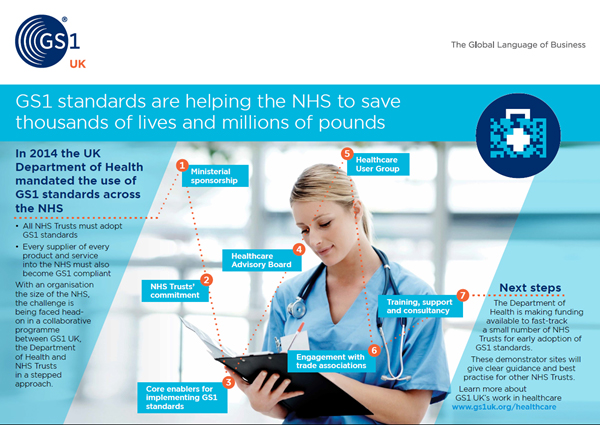May 15, 2015 Industry news
A year on from the eProcurement strategy being published, so much is already under way to achieve significant savings and efficiency gains, while at the same time supporting the NHS to build a better, patient-centric, health service – that’s ready for the future.

Background
In 2014, the Department of Health mandated the use of GS1 standards within the eProcurement strategy, which is part of the department’s National Health Service (NHS) Procurement and Efficiency Programme in England. The adoption of GS1 standards allows for the unique identification of every person, every product and every place across the whole NHS. This will help to improve efficiency, patient safety, patient experience, patient care and clinical performance.
The NHS Procurement and Efficiency Programme is supporting the NHS to harness its immense purchasing power and drive efficiencies to protect frontline care. The Programme produced the eProcurement strategy out of a number of previous reviews and activities, bringing together lessons learned and best practices.
The National Information Board’s Personalised Health and Care 2020, which was published in late 2014, sets out a framework to enable England to become a global leader in the provision of digital health and care services that improve patient safety and transparency.
GS1 UK is supporting the Department of Health and NHS England to embed GS1 global standards across the NHS.
Challenge
With an organisation the size of the NHS, the main challenge is how to achieve the range of efficiencies outlined in the eProcurement strategy and support Personalised Health and Care 2020.
There are varying degrees of “readiness” across NHS Trusts, who all operate at different sizes, the services they offer, level of technology adoption and numbers of patients treated. This needed a collaborative approach to implement GS1 standards.
The NHS must embrace technology to provide seamless healthcare provision centred on patient needs, both inside and outside the hospital setting. By using unique identification standards everywhere along the patient pathway, it is possible to increase efficiency and significantly improve the quality and safety of care.”
Rt Hon Lord Philip Hunt PC OBE
What has been achieved so far?
The challenge is being faced head on in a joint programme between GS1 UK, the Department of Health and NHS Trusts in a stepped approach.
| 1. Ministerial sponsorship | GS1 standards have been included in NHS policies for some years, although their widescale adoption has been patchy. In 2014, the eProcurement strategy received endorsement from the Parliamentary Under Secretary of State for Health. |
| 2. NHS Trusts’ commitment | In support of the programme, each hospital-based Trust was asked to nominate a senior executive to act as GS1 UK lead sponsor for their organisation – for GS1 standards adoption. Today, over 80 percent of Trusts have nominated a lead sponsor. |
| 3. Core enablers and main applications | Adopting three core enablers and three main applications will allow Trusts to provide accurate and real-time records, reduce never-events and drive patient-level costing. Core enablers - Every person (patient identification) Main applications - Purchase to Pay |
| 4. Healthcare Advisory Board | GS1 UK has facilitated the coming together of industry leaders, senior clinical staff and regulators from across UK healthcare to form an advisory board. The board’s aim is to improve patient safety, reduce regulatory non-compliance and realise cost savings from operational efficiencies across the NHS through the adoption and implementation of GS1 standards. |
| 5. Healthcare User Group | GS1 UK, key healthcare users and industry stakeholders regularly meet to discuss the implementation of GS1 standards across healthcare in UK – and in particular the NHS. These sessions support the tactical application of GS1 standards, are a forum to provide advice and technical expertise and to encourage best practice across Trusts as well as manufacturers and suppliers. |
| 6. Engagement with trade associations | The eProcurement strategy states that every supplier of every product and service into the NHS must comply with GS1 standards. GS1 UK and the Department of Health are engaging, through a series of regular meetings, with all the leading trade associations to drive awareness, education and support for the adoption of GS1 standards. |
| 7. Training, support and consultancy | GS1 UK is providing a range of support services to both Trusts and suppliers, from understanding regulations and the benefits of deploying GS1 standards, to the technical aspects of implementation. |
The benefits on offer are transformational
Since the McKinsey report – Strength in unity: the promise of global standards in healthcare, 2012 – the benefits of GS1 standards in healthcare have been widely accepted.
Meeting regulatory compliance
The global nature of GS1 standards means that suppliers to the NHS are naturally prepared for new regulations in the healthcare sector. This includes the UDI regulations already operating in the U.S., with similar UDI regulation expected soon in Europe, as well as the forthcoming European Falsified Medicines Directive.
By placing GS1 standards at the heart of procurement and patient safety, thousands of lives and millions of pounds could be saved through uniquely identifying every person, every product and every place within the NHS.”
Glen Hodgson, Head of Healthcare at GS1 UK
Next steps - demonstrator sites
With the support of GS1 UK and the Department of Health, a small number of NHS Trusts are being chosen for early adoption of GS1 standards, covering a range of trust sizes, services offered and complexity of patients treated. The Department of Health is making funding available to these demonstrator sites to fast-track the full adoption of GS1 standards across the whole of each chosen Trust.
Running from autumn 2015, this demonstrator site activity will give invaluable insight into the practical challenges and opportunities of adopting GS1 standards in a live healthcare environment, an invaluable measure of objective metrics. It will also provide a true validation of the real costs and benefits that can be achieved.